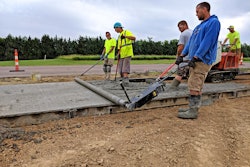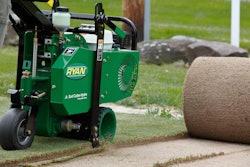
If your client is having drainage issues in his/her landscape, creating a dry creek bed could prove to be the ideal solution. Dry creek beds, sometimes called an arroyo, are shallow trenches lined with landscape fabric and filled with varying sizes of rocks and boulders.
When an area begins collecting excess surface water, dry creek beds act as a useful channel to provide a suitable exit or collection point for the water to slowly soak into the soil.
Not only can this feature help direct water away from areas where it would usually pool, but it also offers an attractive focal point to the yard that requires very little maintenance on the part of the client.
If you think a dry creek bed could be the perfect fit for your customer, take a look at how to create and best utilize these features.
Dry creek bed landscaping
When brainstorming dry creek bed ideas, keep in mind that the size really depends on the surrounding available space.
Scope out the yard and see how the water naturally travels in the space, as this will help you determine the best place to install the feature. Before you start the process, be sure you check and double-check the elevations of the yard and understand which way the water will be directed, especially if the dry creek bed will be installed near an existing structure.
While it’s true you might not need permits to actually install a dry creek bed, be sure you pay close attention to where the water will go once it’s diverted into the bed, as the water will need to be directed appropriately.
In many areas, it’s illegal to divert drainage water into the street due to how it stresses stormwater systems, as well as how it could wash any fertilizers, herbicides or other lawn care chemicals into local waterways.
When possible, work to ensure the water ends up in your customer’s lawn in an area that doesn’t have drainage issues, as this will allow the water to naturally soak back into the ground without fear of excessive pooling. If, however, this is not an option, be sure to talk to your local city officials to seek their recommendation.
Be sure to also avoid diverting the water into neighboring yards
Once you’ve determined the location and flow of the dry creek bed, start by mapping out the style of the bed, keeping in mind that curves will look nice but too many might impede the progress of the water flow. Avoid adding in any sharp turns or going around any unnecessary obstacles.
When possible, work with the natural highs and lows of the yard to encourage a natural flow.
Next, start the excavation process by removing 12-18 inches of soil. Follow this with tamping down the ground, creating a flat surface that will have angled sides. Next, place landscaping fabric over the entirety of the surface and on the sides, as this will help keep weeds from making their way through.
With about ½-inch of crushed pea gravel, cover both the bottom and sides of the dry creek bed. Having the sharper edges of the gravel in place will help keep it from moving and shifting during heavy rain or when exposed to foot traffic.
Once the gravel is in place, add in bigger river rocks along the edges to create a more natural look. To really keep it authentic, incorporate varying sizes and shapes of rocks. This can be done to create either a single row of rocks or it could be doubled to make it look more robust.
Add a final round of spaced-out boulders to the outer edges of the bed, interspersing them with plant life to make it more authentic and natural looking. You can also pile some of the excavated dirt along the sides of the bed to accentuate the trench.










